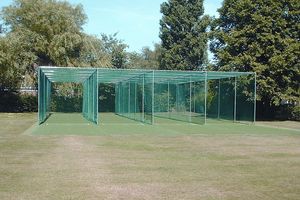Cricket Pitch Dimensions: All The Facts And Figures
From the complex rules to the strict regulations, cricket is a sport that requires a great deal of knowledge and has us asking a lot of questions to keep up with it. One of the most common questions asked about cricket is: what are the dimensions of a cricket pitch?
At first glance, the cricket pitch seems like a simple rectangular area where the bowler bowls and batsmen stand. In reality, however, there are several elements that go into creating a cricket pitch.
We've put together a handy guide to get you up to speed with cricket pitches, from the bowling crease to middle stumps. So, let's dive in!
| Cricket Pitch Element | Measurement |
| Cricket Pitch Turf | 20.12 metres long x 3.05 metres wide |
| Bowling Crease | 2.64 metres long |
| Popping Crease | 1.83 metres long on either side (1.22 metres from the bowling crease) |
| Return Crease | 1.32 metres long on either side (2.44 metres behind the popping crease) |
| Wickets | Tops of cricket stumps should be 71.12 cm from the pitch's ground.
Wooden bails shouldn't be any more than 1.27cm above the stumps. |
What is the Standard Size of a Cricket Pitch?
According to Lords, the standard size of a rectangular cricket pitch is 20.12 metres in length and 3.05 metres in width.
The pitch comprises a rectangular strip in the centre of the field. This is known as the crease. The two sets of stumps are placed at each end of the crease, and all other markings, such as boundaries, circles and crescents, are drawn around them.
The surface of the cricket pitch is typically covered with grass, but artificial pitches can be used, too. With that said, a turf pitch is the preferred option for the majority of cricketers.
It's important that the pitch remains firm throughout the match and that it doesn't become slippery or wet, as this will significantly affect the player's runs. Cricket umpires are tasked with judging the 'fitness of the pitch' and deciding whether a match is to be played on it or not.
Non-turf Cricket Pitch Size
Non-turf cricket pitches can be used to play professional and amateur games of cricket, but Lords require different pitch measurements for these surfaces.
The standard measurements for a non-turf cricket pitch are 17.68m long by 1.83m wide. This is significantly shorter than a standard turf pitch, which alters the way bowlers have to approach the game.
What are the Different Parts of a Cricket Pitch?
A cricket pitch can seem complicated and confusing, particularly if you don’t understand the cricketing terms. To fully understand how the game works, getting familiar with the different parts of the pitch is a must.
The different parts of cricket pitches consist of:
Bowling Creases
The bowling crease is the line which marks the end of the cricket pitch. It is a line drawn to determine the point from which the bowler should bowl. If the bowler touches or crosses the bowling crease, a call of 'no ball' will be made.
The crease should measure 2.64 metres in length and should also be marked with a set of stumps at each end.
Popping Crease
The popping crease on a cricket field should be in front of and running parallel to the bowling crease and should be drawn 1.22 metres from the bowling crease.
The popping crease is a minimum of 1.83 metres on either side of the imaginary line that connects the centres of the two middle cricket stumps.
The current batsman must keep at least one foot behind the popping crease to protect his wicket. The other batsman must stand behind the opposite popping crease marking and not obstruct the bowler or umpire.
Return Creases
The last of the creases on a cricket pitch is the return creases. These cricket pitch markings should be at right angles to the drawn popping crease, 1.32 metres on either side of that same imaginary line.
The return creases sit 2.44 metres behind the popping crease.
The primary use of the return creases is to determine whether a bowler has bowled a 'no ball'. If the bowler steps outside the boundaries of the return crease during the run-up to bowl, the ball will be deemed a 'no ball'.
Wickets
The final element of the cricket pitch dimensions is the wickets. Wickets in cricket are the set of three stumps that the batter is defending, with two wooden bails placed on top of the stumps.
The tops of the cricket wicket stumps should be 71.12 cm from the pitch's ground, and the wooden bails shouldn't project any more than 1.27cm above the stumps.
Are Cricket Pitch Dimensions Always the Same?
The size and dimensions of the cricket pitch markings will always be the same regardless of the country, league or tournament. Every cricket pitch must have the same dimensions to allow the game to be played fairly and consistently.
However, the surface and type of cricket pitch can vary – so long as it conforms to the correct cricket pitch dimensions. For example, a non-turf cricket pitch or an artificial cricket pitch.
Junior Cricket Pitch
In some countries, the size of junior cricket pitch measurements is different to those laid out above, typically to make it easier for children to play the game.
During 2017 and 2018, the ECB conducted research into the best cricket pitch dimensions and formats for players aged 8 to 11 years old. In 2019, a number of cricket pitches across the UK started to use shorter and narrower dimensions that are tailored specifically for junior cricket.
| Age Group | Dimensions according to ECB |
| Under 7s | 16 yards (14.6 metres) |
| Under 9s | 18 yards (16.5 metres) |
| Under 10s | 19 yards (17.4 metres) |
| Under 11s | 20 yards (18.3 metres) |
Women's Cricket Pitch
The dimensions of international women's cricket pitches are the same as the standard pitch length for men's pitches. However, the boundaries of the fielding area are smaller than in men's matches.
For matches, international women's cricket requires the boundaries to be between 55 yards (50.29m) and 70 yards (64m).
This difference in boundary markings is to increase the rate of boundaries hit in women's cricket to align with the rate seen in the men's game.
Summary: The Essential Cricket Pitch Dimensions
Understanding the intricacies of a cricket pitch's dimensions and markings is vital to fully appreciate the game. From the specific lengths of the creases to the placement of the wickets, each detail impacts how the game unfolds.
So the next time you watch a match or step onto a pitch, remember, it's more than just a field!
Set Up Your Cricket Pitch With Huck Nets
If you want to create your own cricket pitch for matches and practices, why not check out our range of cricket nets, boundaries, and ground equipment at Huck Nets?
FAQs
What is the Difference Between a Turf Pitch and a Non-turf Pitch?
There are a few differences between a turf pitch and a non-turf pitch. Other than the cricket pitch length being different, the main difference is in the performance of the pitch. A non-turf cricket field provides more consistent performance and safety and better durability than a natural turf surface.
Are Cricket Pitch Dimensions the Same Globally?
The field used in cricket doesn't have to adhere to any strict dimensions. The diameter usually sits somewhere between 140m and 150m for men's cricket and 110m and 130m for women's cricket. On the other hand, the rectangle pitch generally adheres to the standard guidelines set out above.
Where Can I Find ECB-Approved Knotless Cricket Netting And Cricket Training Accessories For Practice And Play?
Here at Huck Nets, we stock a range of ECB-approved indoor and outdoor cricket nets. The high-tenacity netting is UV-protected and weather-resistant, ensuring long-lasting protection in all weather conditions. We use high-quality, knotless netting that is ricochet-proof, providing safety for you and your teammates during practice.
We also offer a range of cricket bowling machines and accessories to help facilitate your fielding and batting practice.
Can Cricket Pitches Vary in Surface Type?
Absolutely! Cricket pitches only have to adhere to the standard pitch measurements we mentioned above. Aside from that, the surface type can vary depending on the location and what players prefer. Other than natural turf pitches, a cricket match can be played on artificial turf, woven, tufted, or needle-punched surfaces.
Are the Dimensions of Women's Cricket Pitches Different from Men's?
Cricket pitch length is the same for both men's and women's cricket pitches. The difference lies in the distance of the boundary line from the pitch – between 55 and 70 yards, compared to 65 to 90 yards for men. Women play on a full-sized pitch, but the boundary line is closer to allow for more boundaries to be hit by the cricket players.


